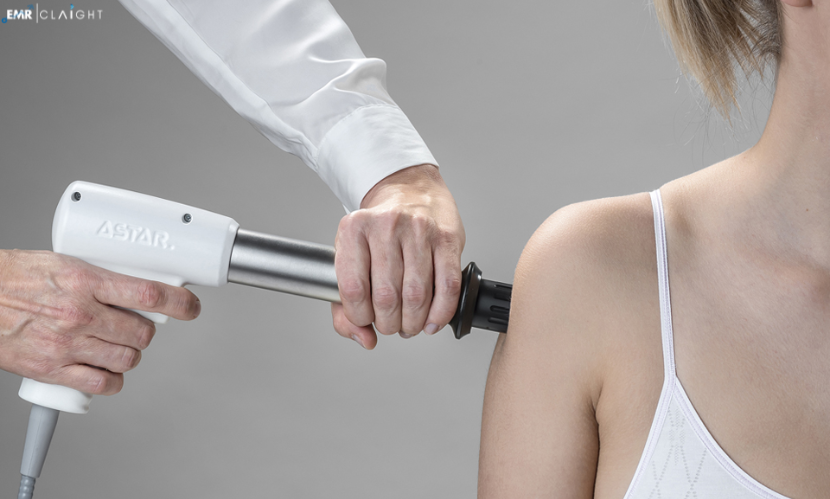Global shock wave therapy device market

The shock wave therapy devices market has seen significant growth in recent years, primarily driven by the increasing adoption of non-invasive treatment methods, especially in physiotherapy. In 2023, the market size for shock wave therapy devices reached USD 1.75 billion and is projected to expand at a Compound Annual Growth Rate (CAGR) of 7.7% from 2024 to 2032, ultimately reaching USD 3.45 billion by 2032. The growth of the market is attributed to rising healthcare awareness, technological advancements, and a growing demand for physiotherapy treatments globally.
Key Market Insights
Shock wave therapy is a non-invasive treatment that uses high-energy sound waves to promote healing in various musculoskeletal disorders. It is widely used for treating conditions such as tendinitis, plantar fasciitis, calcific shoulder tendinopathy, and erectile dysfunction, among others. These therapies provide an alternative to traditional treatments like surgery and medication. The increasing focus on effective, pain-free treatments has fuelled the rise in shock wave therapy usage.
With the market anticipated to grow at a healthy pace during the forecast period, it is crucial to examine the drivers, challenges, opportunities, trends, and key players influencing the market.
Market Segmentation
The shock wave therapy devices market can be segmented based on type, application, end-user, and region.
Get a Free Sample Report with Table of Contents: https://www.expertmarketresearch.com/reports/shock-wave-therapy-device-market/requestsample
By Type
- Focused Shock Wave Therapy (FSWT): Focused shock wave therapy delivers precise energy to a specific area and is typically used for deeper tissues. It is commonly used in orthopaedic applications to treat chronic pain conditions.
- Radial Shock Wave Therapy (RSWT): Radial shock wave therapy generates waves that spread out in all directions from the applicator. It is typically used for treating more superficial conditions, such as muscle and tendon injuries.
By Application
- Orthopaedics: Orthopaedic applications account for the largest market share due to the prevalence of musculoskeletal disorders such as tendonitis, osteoarthritis, and ligament injuries.
- Urology: Shock wave therapy is also used in urology to treat conditions like erectile dysfunction and kidney stones.
- Physiotherapy: Physiotherapists use shock wave therapy for rehabilitation purposes, promoting faster healing for soft tissue injuries.
- Aesthetic Treatments: Increasing use in aesthetics for skin tightening and cellulite reduction is a new growth area.
By End-User
- Hospitals and Clinics: These institutions account for a significant share, as they provide comprehensive healthcare services including rehabilitation and physiotherapy.
- Homecare Settings: Growing interest in home-use devices, especially for pain management and injury recovery, is likely to contribute to market growth.
- Sports Institutes: With the rise in sports-related injuries, sports centres are increasingly incorporating shock wave therapy into their treatment protocols.
By Region
- North America: Dominates the market due to the high adoption rate of advanced medical technologies and rising healthcare expenditure.
- Europe: Exhibits a strong market presence owing to increasing demand for non-invasive treatments and growing healthcare awareness.
- Asia-Pacific: A rapidly growing market due to expanding healthcare infrastructure and rising consumer demand for non-invasive treatments.
- Latin America and Middle East & Africa: Emerging regions, these areas are witnessing increased adoption of shock wave therapy devices driven by improving healthcare facilities.
Key Players in the Market
Several companies are at the forefront of the shock wave therapy devices market, contributing to product innovation, research, and development.
- STORZ Medical AG: Based in Switzerland, STORZ Medical is a leading player in the shock wave therapy device market, offering both radial and focused shock wave devices for various applications.
- Zimmer MedizinSysteme GmbH: A prominent German company known for developing cutting-edge medical technologies, including shock wave therapy devices.
- MTS Medical UG: With its headquarters in Germany, MTS Medical focuses on developing and producing shock wave devices for both medical and aesthetic applications.
- EMS Electro Medical Systems: This Swiss-based company is another key player, known for its shock wave devices used primarily in musculoskeletal rehabilitation.
- BTL Industries: A global leader in medical devices, BTL Industries produces shock wave therapy devices for a wide range of therapeutic applications.
Market Trends
Several key trends are influencing the growth of the shock wave therapy devices market:
-
Non-invasive Treatment Popularity: Patients are increasingly seeking non-invasive treatments to avoid the side effects and recovery times associated with surgeries. Shock wave therapy devices cater to this demand, offering effective treatments with minimal downtime.
-
Technological Advancements: Advances in shock wave technology, such as the development of portable devices, have made treatments more accessible. Additionally, digitalization and integration with mobile apps for monitoring treatment progress are expected to increase the appeal of these devices.
-
Increased Use in Physiotherapy and Sports Medicine: Shock wave therapy has gained popularity in the physiotherapy and sports medicine sectors, as it is effective in promoting tissue healing, improving mobility, and relieving pain from various injuries.
-
Rising Awareness of Musculoskeletal Disorders: As awareness regarding musculoskeletal disorders and their management increases, more people are turning to physiotherapy treatments like shock wave therapy, leading to market expansion.
-
Aesthetic Applications: The use of shock wave therapy for aesthetic purposes, including cellulite reduction and skin rejuvenation, is gaining popularity, presenting new growth opportunities.
COVID-19 Impact on the Market
The COVID-19 pandemic had a significant impact on the healthcare sector, including the shock wave therapy devices market. Initially, the market experienced disruptions due to lockdowns, delayed medical procedures, and restrictions on non-essential healthcare services. However, the rising demand for alternative treatments and physiotherapy during the pandemic has driven the adoption of non-invasive therapies, including shock wave therapy.
The post-pandemic recovery phase is expected to further fuel growth, with more individuals opting for treatments that offer quicker recovery times and less risk of infection compared to traditional procedures.
Market Outlook
Looking ahead, the shock wave therapy devices market is poised for significant growth. By 2032, the market is expected to reach USD 3.45 billion, driven by the increasing global demand for physiotherapy and rehabilitation. The continuous advancements in shock wave technology and the expanding applications in both medical and aesthetic fields are expected to contribute to market growth.
The market will also benefit from the growing prevalence of musculoskeletal conditions, an aging population, and increasing focus on preventive care and rehabilitation. Emerging markets, particularly in the Asia-Pacific and Latin American regions, will continue to experience rapid growth due to improvements in healthcare infrastructure and increased awareness of non-invasive treatment options.
Market Size and Share
As mentioned earlier, the shock wave therapy devices market attained a value of USD 1.75 billion in 2023. With a projected CAGR of 7.7% from 2024 to 2032, this market is set to expand substantially in the coming years. The market share is expected to be dominated by North America, followed by Europe, which together will account for the largest share, owing to their advanced healthcare systems and high demand for innovative therapeutic solutions.
Asia-Pacific is projected to witness the highest growth, driven by rapid urbanisation, increasing healthcare expenditure, and rising adoption of advanced medical technologies.
Related Trending Reports

